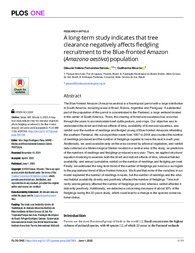A long-term study indicates that tree clearance negatively affects fledgling recruitment to the Blue-fronted Amazon (Amazona aestiva) population.
A long-term study indicates that tree clearance negatively affects fledgling recruitment to the Blue-fronted Amazon (Amazona aestiva) population.
Autoria: SEIXAS, G. H. F.; MOURAO, G.
Resumo: he Blue-fronted Amazon (Amazona aestiva) is a Neotropical parrot with a large distribution in South America, including areas in Brazil, Bolivia, Argentina and Paraguay. A substantial part of the population of this parrot is concentrated in the Pantanal, a large wetland located in the center of South America. There, the clearing of forest and savannas has occurred through the years to accommodate beef-cattle pasture, and crops. Our objective was to understand the direct and indirect effects of time, availability of forest and savannas, and rainfall over the number of nestlings and fledged young of Blue-fronted Amazons inhabiting the southern Pantanal. We surveyed their nests from 1997 to 2018 and counted the number of nestlings produced and the number of fledglings capable to leave the nest in each year. Additionally, we used available data on the area covered by arboreal vegetation, and rainfall data collected at a Meteorological Station located in a central area of the study, as predictors of the numbers of nestlings and fledglings produced every year. Then, we applied structural equation modeling to examine both the direct and indirect effects of time, arboreal habitat availability, and annual cumulative rainfall on the number of nestlings and fledgling per nest. Finally, we estimated the long-term trend of the number of fledglings per nest as a surrogate to the populational trend of Blue-fronted Amazon. We found that none of the variables in our model explained the number of nestlings in nests, but the number of nestlings and the arboreal habitat availability directly and positively affected the number of fledglings. Time indirectly and negatively affected the number of fledglings per nest, whereas rainfall affected it indirectly positively. Additionally, we detected a concerning decrease of about 30% of the fledglings during the 22-years study, which could lead to a change in the species conservational status.
Ano de publicação: 2022
Tipo de publicação: Artigo de periódico
Unidade: Embrapa Pantanal
Palavras-chave: Animal behavior, Ave Selvagem, Comportamento Animal, Conservação, Papagaio, Papagaio verdadeiro, Parrots, Wild birds
Observações
1 - Por padrão são exibidas publicações dos últimos 20 anos. Para encontrar publicações mais antigas, configure o filtro ano de publicação, colocando o ano a partir do qual você deseja encontrar publicações. O filtro está na coluna da esquerda na busca acima.
2 - Para ler algumas publicações da Embrapa (apenas as que estão em formato ePub), é necessário ter, no celular ou computador, um desses softwares gratuitos. Sistemas Android: Google Play Livros; IOS: iBooks; Windows e Linux: software Calibre.
Acesse outras publicações
Acesse a Base de Dados da Pesquisa Agropecuária (BDPA) para consultar o acervo completo das bibliotecas da Embrapa.

